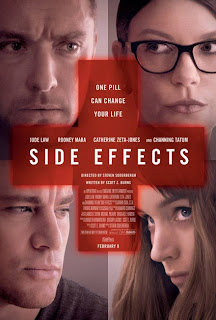Steven Soderbergh’s new
film is a film that shows the pain of a dysfunctional mind with the dangers of
an opportunistic society. New York City
is represented as a mass of venture capitalists, medicated trophy wives and heartless
medical-insurance vampires – and amongst them lis this thriller starring a young women
and her psychiatrist.
The plot of the film follows
a graphic designer called Emily (Rooney Mara) who is battling with depression
due to her husband being sent to / released from jail for insider trading (he
is just getting out as the film starts).
She gets offered a role on a medical trial involving a new medication
from her psychiatrist Dr. Jonathan Banks (Jude Law). The drug has unexpected side effects (to say
the least) and the film becomes a meditation on who is to blame for the actions
of heavily medicated people: the doctor who wrote the prescription, or the
patient who has acted in an unexpected way.
There are a number of
scenes that must seem very familiar to American audiences but seem insane
through English eyes. For example, there
is a scene where Dr. Banks is taken to lunch by a drug company who offer him
$50,000 to recruit possible patients to a new drug trial. There are two scenes where other women notice
Emily’s depression and give her advice about different psychiatric meds – as if
discussing diets or skincare advice.
This film is a clear accompaniment to the discussion on American
healthcare that exploded during the first Obama administration, and I feel that
it sides with the view that there is too much money / competition in the
system. If the release date for the film had been during the run-up to the Supreme Court's decision on the constitutionality of the Affordable Healthcare Act, then it might have seemed as polemic as Fahrenheit 911.
The most interesting
element of the film though for me was the symbolism given to architecture in
the narrative (and the cinematography).
The first shot over the credit sequence is a slow, Hitchcockian pan/zoom
into a window of an apartment that belongs to Emily. Later there is an important scene with an exit
sign on the wall of a car park, and there are lots of moments where the camera
lingers on a wall or a floor for a noticeable time. This gives the impression that the buildings
themselves are characters in the film:
The slick apartments owned by Emily and Dr. Banks – Emily’s modern,
liberal workplace full of glass and iMacs, the prison / courtroom / hospital /
subway station / psychiatric ward that feature as symbolic areas of state
control. The buildings are given a
special significance as places to be trapped; much like Emily feels of her own
mind. The film is shot in soft focus as
the effects of the drugs are offered visually to the viewer, and the music
lends a beautiful atmosphere as the visuals float past in between the action
scenes.
The result is a film
that I imagine will intrigue those in search of a good plot and yet anger those
who demand that the status quo is bitterly upheld in the healthcare
argument. Any comment on the industry is
an attack on a system that is ideologically revered by the people who seem to need
reform the most…
(There is a great website promoting the drugs that Emily is prescribed here)
(There is a great website promoting the drugs that Emily is prescribed here)

No comments:
Post a Comment